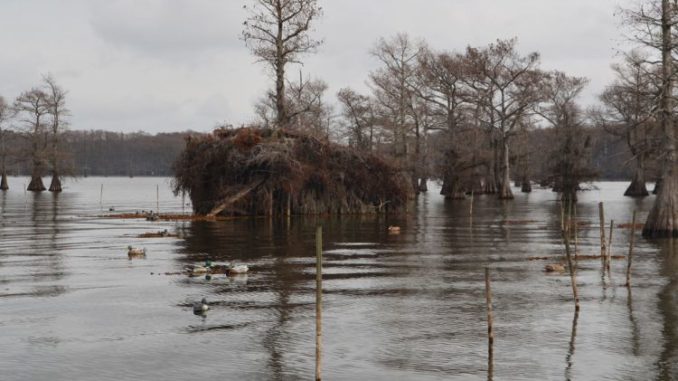
Todd Hopkins, who lives on the lake, described it as an average duck hunting lake, one that can produce limit kills as well as one that can produce blanks.
Brandon Garner agreed. “When they are here, they are here. When they are gone, they are gone. Best hunting is the day after a front.
“Those will be bluebird days. Some hunters complain about them, but on this lake they are good.”
“The lake doesn’t hold a lot of ducks on a permanent basis,” interjected Hopkins. “After a front, they stay a week at the most, and then they are gone. Except wood ducks. A lot of wood ducks are resident birds.”
“Another thing about this lake is that people need to stick it out,” added Garner. “Don’t leave early. When I was younger, we would leave by 8:45 a.m. An older guy hunting near us would always kill a limit. We never could figure out why.
“One day, he came to our blind. ‘Fellas,’ he said, ‘I’ve got one piece of advice for you. You’re leaving too early.’ We stayed and we started killing more ducks — mallards!”
He demonstrated his patient technique by rummaging in his hunting bag and whipping out a Honey Bun. “Y’all watch,” he grinned broadly. “They’ll come now.
“They smell ‘em. I’ve got all kinds of healthy food in my pack, but I’m sacrificing myself for you,” he said while munching a big bite.
The duo laid out the typical annual duck hunting cycle in Caddo Lake. The first split of the season opens with wood ducks, teal, spoonbills (shovelers) and some blackjacks (ring-necks).
By the second or third week of the split, gadwalls arrive in significant numbers, providing good kills. Toward the end of the season, mallards begin to show up, especially associated with cold fronts.
Overall, ducks occur in fairly stable numbers during the first split, with bumps on cold fronts.
During the second split, hunting falls off noticeably. Hunters should concentrate their efforts on cold fronts, which can provide three or four days of good hunting. Occasionally, strong south winds in advance of a cold front will bring birds into the lake.
In the second split more pintails will be seen, and in the last three weeks of the season some canvasbacks will drop in. Strong northwest winds will also at times trigger flights of wigeons. Some scaup are also taken in the second split, while teal are almost absent from kills.